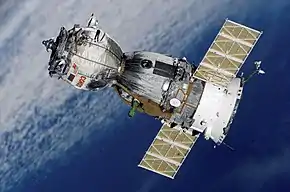Kosmos 133
Kosmos 133 (Russian: Космос 133, meaning "Kosmos 133"), Soyuz 7K-OK No.2, was the first uncrewed test flight of the Soyuz spacecraft, and first mission of the Soyuz programme, as part of the Soviet space programme.
_drawing.png.webp) Soyuz 7K-OK spacecraft with an active docking unit. | |
| Mission type | Test Flight |
|---|---|
| Operator | Experimental Design Bureau (OKB-1) |
| COSPAR ID | 1966-107A |
| SATCAT no. | 02601 |
| Mission duration | 1 day, 23 hours and 19 minutes |
| Spacecraft properties | |
| Spacecraft | Soyuz 7K-OK No.2 |
| Spacecraft type | Soyuz 7K-OK |
| Manufacturer | Experimental Design Bureau (OKB-1) |
| Launch mass | 6450 kg [1] |
| Landing mass | 2500 kg |
| Dimensions | 7.13 m long 2.72 m wide |
| Start of mission | |
| Launch date | 28 November 1966 11:02:00 GMT [2] |
| Rocket | Soyuz 11A511 s/n U15000-02 |
| Launch site | Baikonour, Site 31/6 |
| Contractor | Experimental Design Bureau (OKB-1) |
| End of mission | |
| Disposal | Exploded: on the self-destruct command of ground |
| Landing date | 30 November 1966, 10:21 GMT (explosed) |
| Landing site | Kazakh Steppe of Kazakhstan (planned) |
| Orbital parameters | |
| Reference system | Geocentric orbit [2] |
| Regime | Low Earth orbit |
| Perigee altitude | 171.0 km |
| Apogee altitude | 223.0 km |
| Inclination | 51.9° |
| Period | 88.4 minutes |
Launch
Launched from the Baikonur Cosmodrome aboard the maiden flight of the Soyuz 11A511 s/n U15000-02 launch vehicle.[3] Kosmos 133 was planned "all up" test, to include an automated docking with a second Soyuz spacecraft (Soyuz 7K-OK No.1), which was scheduled for launch the day after Kosmos 133.
Mission
Kosmos 133 was operated in a low Earth orbit, on 28 November 1966, it had a perigee of 171.0 km (106.3 mi), an apogee of 223.0 km (138.6 mi), an inclination of 51.9°, and an orbital period of 88.4 minutes.[2]
Return
Problems found during ground testing of the second spacecraft resulted in its launch being delayed, and it was destroyed when its launch vehicle exploded on its launch pad following a scrubbed launch attempt in December 1966. Before this, the attitude control system (ACS) of Kosmos 133 malfunctioned, resulting in rapid consumption of orientation fuel, leaving it spinning at 2 rpm. After large efforts by ground control and 5 attempts at retrofire over two days, the craft was finally coming down for a landing. Due to the inaccuracy of the reentry burn, it was determined that the capsule would land in China. The self-destruct command was given and the satellite exploded 30 November 1966 at 10:21 GMT.[1]
The fireball passed over west Japan and was recorded by photos and a sketch. Kōichirō Tomita identified that it was the Kosmos 133 spacecraft (30 November 1966).[4]
References
- "Display: Kosmos 133 1966-107A". nssdc.gsfc.nasa.gov. NASA. 14 May 2020. Retrieved 15 October 2020.
 This article incorporates text from this source, which is in the public domain.
This article incorporates text from this source, which is in the public domain. - "Trajectory: Kosmos 133 1966-107A". nssdc.gsfc.nasa.gov. NASA. 14 May 2020. Retrieved 15 October 2020.
 This article incorporates text from this source, which is in the public domain.
This article incorporates text from this source, which is in the public domain. - McDowell, Jonathan. "Launch Log". Jonathan's Space Page. Retrieved 31 March 2020.
- 加茂昭, Kamo, Akira (2012). 空とぶマネキン人形 [Flying Mannequin Doll / Mannequin Cosmonaut]. Japan: Seikosha 星湖舎. ISBN 9784863720275.
